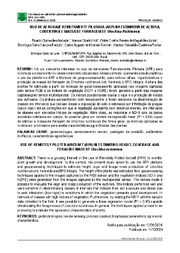Uso de Aeronave Remotamente Pilotada (ARP) na estimativa de altura, cobertura e massa de forragem de Urochloa ruziziensis.
Uso de Aeronave Remotamente Pilotada (ARP) na estimativa de altura, cobertura e massa de forragem de Urochloa ruziziensis.
Author(s): ANDRADE, R. G.; HOTT, M. C.; MAGALHAES JUNIOR, W. C. P. de; PACIULLO, D. S. C.; GOMIDE, C. A. de M.; ROCHA, W. S. D. da
Summary: RESUMO: Há um crescente interesse no uso de Aeronaves Remotamente Pilotada (ARP) para monitorar o crescimento e o desenvolvimento das plantas. Nesse contexto, o presente estudo objetivou o uso da plataforma ARP e técnicas de geoprocessamento, para estimar altura, vigor/cobertura e produção de massa de forragem de Urochloa ruziziensis cvs. Kennedy e BRS Integra. A altura das plantas foi estimada a partir de técnicas de geoprocessamento aplicadas nas imagens captadas pelo sensor RGB e os índices de vegetação (NDVI e NDRE) foram gerados a partir das imagens captadas pelo sensor multiespectral. Os índices possibilitaram avaliar o vigor e a produção de massa das cultivares. Os índices apresentaram bom desempenho e foram sensíveis na discriminação de classes em intervalos que indicam desde a exposição do solo e estresses por infestação de pragas (baixo vigor) até as condições em que a vegetação apresenta bom desenvolvimento, em intervalos de classes com elevados índices de vegetação. Além disso, ao relacionar o NDVI com os dados amostrais coletados em campo, foi possível gerar um modelo de regressão linear (R2 = 0,95) capaz de estimar a massa de forragem de Urochloa ruziziensis. De forma geral, as técnicas aplicadas se mostraram promissora para avaliar características agronômicas das plantas. ABSTRACT: There is a growing interest in the use of Remotely Piloted Aircraft (RPA) to monitor plant growth and development. In this context, the present study aimed to use the ARP platform and geoprocessing techniques to estimate height, vigor and forage mass production of Urochloa ruziziensis cvs. Kennedy and BRS Integra. The height of the plants was estimated from geoprocessing techniques applied to the images captured by the RGB sensor and the vegetation indices (NDVI and NDRE) were generated from the images captured by the multispectral sensor. The indices made it possible to evaluate the vigor and mass production of the cultivars. The indices performed well and were sensitive in discriminating classes in intervals that indicate from soil exposure and stress due to pest infestation (low vigor) to conditions in which the vegetation presents good development, in intervals of classes with high indices of vegetation. Furthermore, by relating the NDVI with the sample data collected in the field, it was possible to generate a linear regression model (R2 = 0.95) capable of estimating the forage mass of Urochloa ruziziensis. In general, the techniques applied proved to be promising to evaluate the agronomic characteristics of plants.
Publication year: 2024
Types of publication: Journal article
Unit: Embrapa Dairy Cattle
Observation
Some of Embrapa's publications are published as ePub files. To read them, use or download one of the following free software options to your computer or mobile device. Android: Google Play Books; IOS: iBooks; Windows and Linux: Calibre.
Access other publications
Access the Agricultural Research Database (BDPA) to consult Embrapa's full library collection and records.
Visit Embrapa Bookstore to purchase books and other publications sold by Embrapa.

